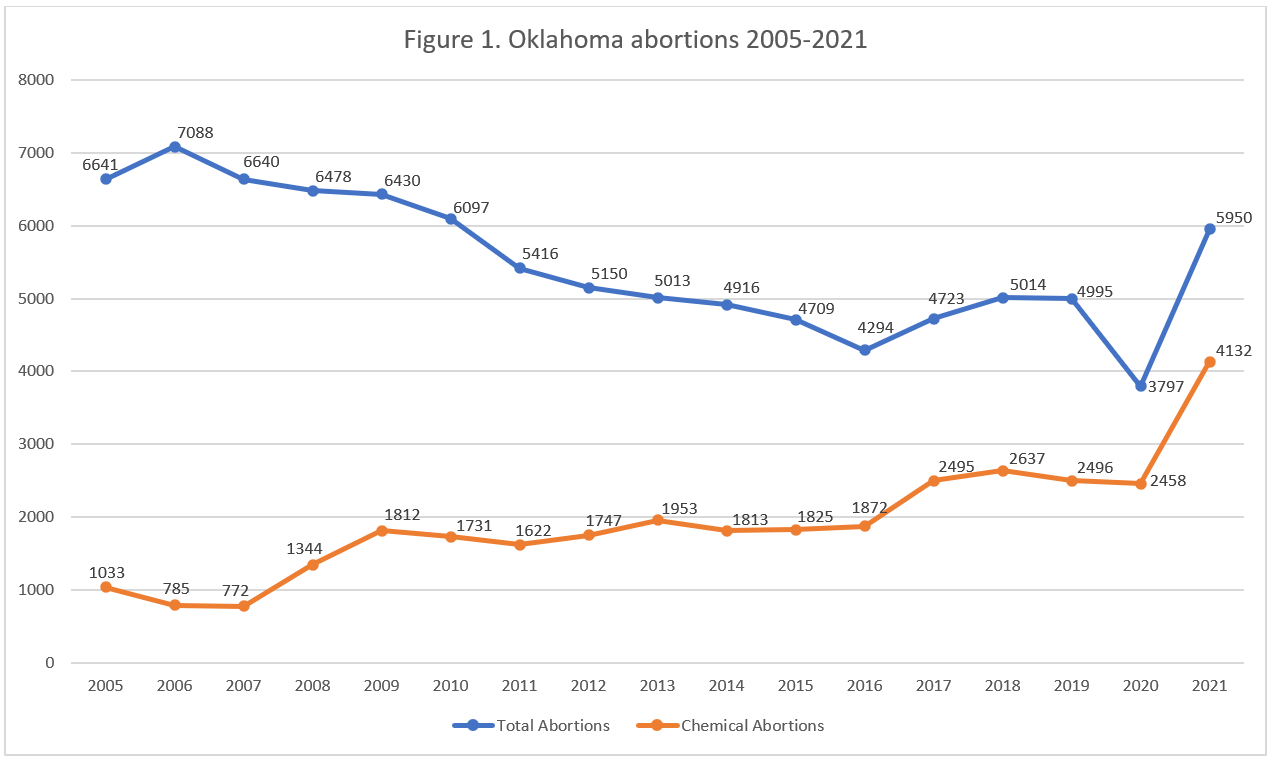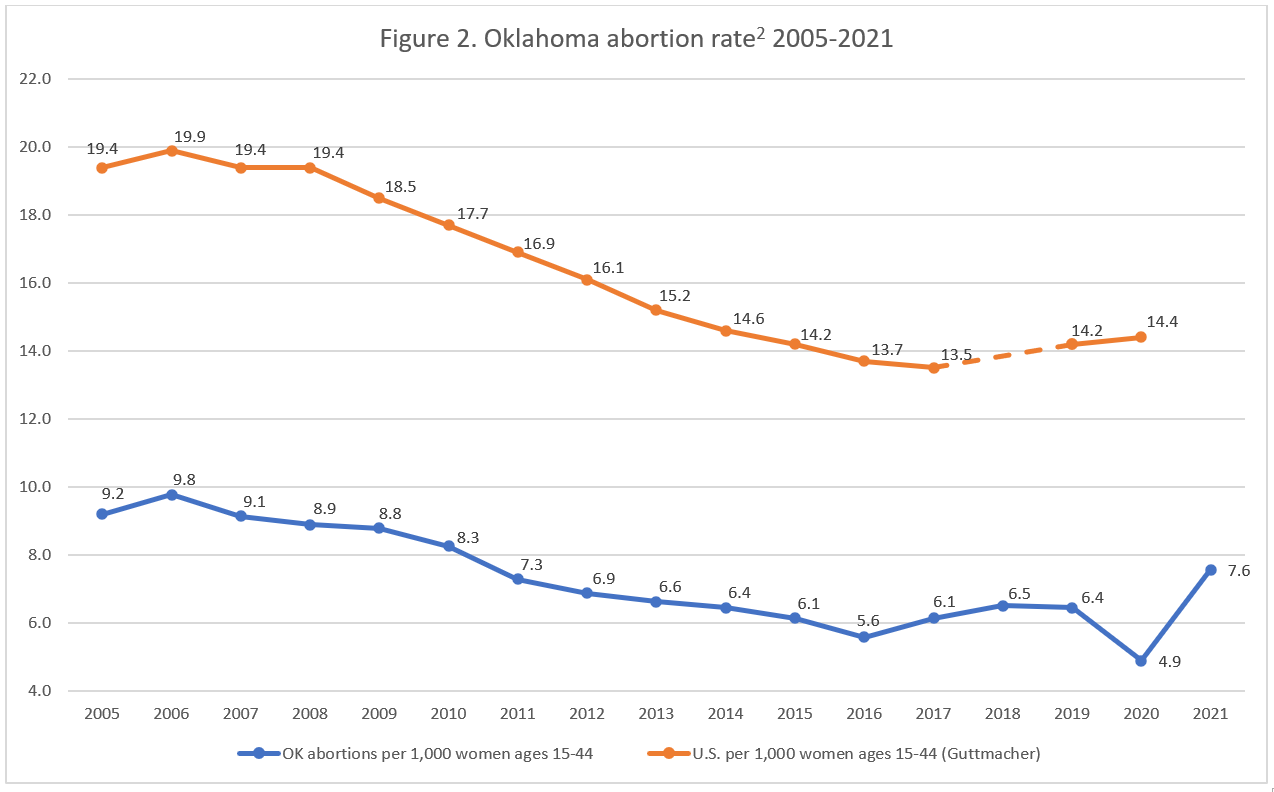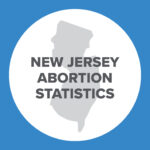Abortion Reporting: Oklahoma (2021)
Oklahoma’s 2021 abortion report was published online by the Oklahoma State Department of Health (OSDH) in May 2022. The report shows that abortions increased in the Sooner State.
Statistics and Changes in Oklahoma Abortions, 2020-2021

The report does not include information on Planned Parenthood’s Oklahoma abortion market share.
Abortion Totals and Trends
There were 5,950 abortions reported in Oklahoma in 2021, up 57 percent from 3,797 in 2020 (Fig. 1). Chemical abortions jumped 68% from 2,458 in 2020 to 4,132 in 2021, making up 69 percent of total Oklahoma abortions. The Charlotte Lozier Institute (CLI) estimates that Oklahoma’s state abortion rate increased 55 percent to 7.6 abortions per 1,000 women ages 15 to 44 but remained lower than the national rate (Fig. 2). As of October, 19 states had published 2021 abortion data, with 14 states indicating that abortions had increased from the previous year.
State Report Summary
In 2021, 62 percent of Oklahoma abortions were performed on state residents, 34 percent were on nonresidents, and four percent were obtained by women of unknown residency. Eleven percent of Oklahoma abortions were performed on girls under the age of 20. Thirty-five percent were obtained by women ages 20 to 24, and 26 percent were on women ages 25 to 29. Seventeen percent of the abortions were performed on women ages 30 to 34, and 12 percent were on women ages 35 and older.
Just over half the abortions reported in Oklahoma (52 percent) were performed on white women. Twenty-one percent were obtained by black women, while six percent were performed on American Indian or Alaska Native women and four percent were on Asian or Pacific Islander women. Fifteen percent were performed on women of other races. The black abortion rate in Oklahoma (18.7 abortions per 1,000 women ages 15 to 44) was 3.3 times higher than the white abortion rate of 5.6.
Eight percent of Oklahoma abortions were conducted on women who had not graduated from high school, while 44 percent were on women with a high school diploma or GED. A third of the abortions were obtained by women who had attended some college, and 14 percent were on women with a bachelor’s degree or more. Eighteen percent of the abortions were performed on married or separated women, and 82 percent were performed on women who were not married.
Thirty-one percent of the abortions reported in Oklahoma were performed on women who had never been pregnant before. Twenty-one percent were on women with one previous pregnancy, and 49 percent were on women with two or more prior pregnancies. Thirty-eight percent of the abortions were obtained by women with no prior live births, compared to 15 percent on women with one live birth and 23 percent on women with more than one. The number of previous live births was not reported for 24 percent of the abortions. Fifty-nine percent of the abortions were performed on women with no previous abortions, 12 percent were on women with one prior abortion, and five percent were on women with more than one. The number of prior abortions was not reported for 24 percent.
Women obtaining abortions in Oklahoma are asked to report their reasons for choosing abortion; multiple reasons may be provided for a single abortion. As in previous years, most abortions were performed for economic or social reasons. There were 52 forms that indicated that the abortions met the definition of medical emergency in Section 1-738.1A of Oklahoma Statutes and 11 that qualified as medical emergencies under Section 1-745.2, both of which define a medical emergency as an immediate physical risk to the woman’s life or a major bodily function. There were 59 forms that indicated the abortion was necessary to save the mother’s life, although the report does not include whether the risk was immediate. Twenty-one abortions were performed for rape and 11 for incest.
Medical
A large majority of Oklahoma abortions, 69 percent, were chemically induced. Fifteen percent were performed using suction aspiration, and seven percent were performed via dilation and curettage. Two percent were dilation and evacuation procedures. There were seven abortions performed using some other means, while the type of procedure was not reported for five percent of the abortions. For 69 percent of the chemical abortions (2,848 abortions), the physician was in the room with the woman when the drug was administered.
Not quite two-thirds of the abortions performed in Oklahoma occurred at eight weeks of gestation or earlier. Eighteen percent were reported between nine and 10 weeks of gestation, and seven percent were performed between 11 and 12 weeks. Six percent occurred between 13 and 15 weeks and two percent were performed between 16 and 20 weeks of gestation, while six abortions were performed at 21 weeks of gestation or later. Gestational age was not reported for 26 abortions. Oklahoma limits abortion at 20 weeks post-fertilization, approximately 22 weeks of gestation, and requires that post-fertilization age be determined except in medical emergencies. Probable post-fertilization (PPF) age was determined for 60 percent of the abortions and not determined for four percent. PPF age was “not applicable” for 33 percent of the abortions, although the report did not indicate why the requirement was not applicable, and for three percent of the abortions it was not reported whether PPF had been measured.
Fifty-two percent of the abortions were performed by OB-GYNs, and 47 percent were performed by general practitioners. The physician’s specialty was not reported for almost one percent of the abortions. Oklahoma collects information on whether the doctor performing an abortion possessed hospital admitting privileges, but this information was suppressed in the report. For fourteen percent of the abortions, the woman was provided with anesthesia, while for 0.1 percent (eight abortions) the unborn baby was anesthetized.
An ultrasound was performed in advance of 98 percent of Oklahoma abortions (67 percent abdominal, 32 percent vaginal, and one percent both abdominal and vaginal). When a pregnancy has reached eight weeks post-fertilization or later, the woman must be offered the opportunity to hear her baby’s heartbeat; in 2021, 752 women (13 percent of the total) had the heartbeat made audible for them to hear.
Fourteen percent of the unborn babies killed by abortion were discarded as medical waste. Eight percent were disposed of at home, and four percent were incinerated. The method of disposal was not reported for 74 percent of the abortions. There were eight abortions for which it was known whether the unborn baby was a boy or girl, but the numbers of babies of each sex were suppressed.
Fifty-two abortions were reported to result in complications in 2021.1 Of these, 39 were reported by the physician who performed the abortion, and 13 were reported by a different physician. There were 15 incomplete abortions in which pieces of the unborn baby or other tissue were left in the woman’s uterus and five failed abortions in which the pregnancy was ongoing. Uterine perforation was reported nine times, and other, unspecified complications occurred 17 times. The number of instances of hemorrhage or heavy bleeding was suppressed. No women were known to have died from abortions in 2021, and no babies were reported to have been born alive.
Legal and Financial
Oklahoma’s informed consent law ensures that a woman is provided with the medical facts about her abortion and the options and alternatives available to her, except in cases of medical emergencies. Over 99 percent of the women undergoing abortion were given the informed consent material, and 29 percent chose to have more information mailed to them. When an abortion is performed after 20 weeks of gestation, additional informed consent material must be provided; in 2021, there were 33 abortions after 20 weeks, but all of these fell under the medical emergency exception to the informed consent requirement.
In Oklahoma, public facilities or employees are prohibited from performing abortions unless an abortion is due to rape, incest, or a risk to the mother’s life. In 2021, the number of abortions performed within the scope of a public employee or agency was suppressed. The previous year, a large number of abortions were incorrectly reported as having taken place in the scope of a public employee’s employment, and the Oklahoma State Department of Health had informed CLI that the abortion centers would conduct training to prevent misreporting in the future.
Parental notification and consent must be provided before an abortion is performed on a minor in Oklahoma. In 2021, there were 122 cases in which parental consent was obtained in advance of the abortion. There were 21 instances in which parental consent was not obtained due to a medical emergency. In 12 cases, a parent was subsequently notified, and in another 12 cases, a judicial waiver to the parental consent was granted. The report does not provide additional details on the circumstances in which both parental notification and a judicial waiver were sought.
Nearly all the abortions reported in Oklahoma (99 percent) were self-pay. Twenty-four abortions were covered by private insurance, and 38 were funded using some other means. The number of Medicaid-funded abortions was suppressed. The method of payment was not reported for 16 abortions.
The majority of Oklahoma abortions cost more than $600, with just five percent performed for less than $500 and two percent for $501 to $600. Eighty-four percent of the abortions cost $600 to $800, and nine percent cost over $800.
Changing Abortion Volumes in Oklahoma
The increase in abortions in Oklahoma in 2021 was driven by abortions on women from out-of-state. Compared to 2020, in 2021 there were approximately 500 more abortions on Oklahoma residents, over 1,400 more abortions on nonresidents, and around 200 more abortions on women of unknown residency. Abortions on Texas residents jumped 289 percent, making up 22 percent of total Oklahoma abortions compared to nine percent in 2020. This was likely a result of Texas’ heartbeat law limiting abortion at approximately six weeks of gestation. Planned Parenthood claimed that women from Texas composed over half of total Oklahoma Planned Parenthood clients in September-December 2021, compared to under 10% in September-December 2020.
However, as a result of laws enacted in 2022, Oklahoma is no longer a destination for out-of-state women seeking abortions. In early May, a law went into effect limiting abortion at six weeks of gestation, similar to Texas’ law. Ahead of Governor Stitt signing the bill into law, Planned Parenthood’s two Oklahoma abortion centers decided to stop performing all abortions, including those earlier than six weeks, although two other abortion centers not affiliated with Planned Parenthood continued performing abortions. Soon after, another law went into effect limiting all abortions at any gestation except in cases of rape, incest, or a risk to the mother’s life. All of Oklahoma’s abortion centers have ceased performing abortions.
State Ranking
In CLI’s 2016 paper evaluating abortion reporting across the 50 states, Oklahoma claimed first place. Although unborn babies are now protected in Oklahoma, abortion reporting remains important. Since some women may travel out of state for abortions or attempt to order abortion pills online, Oklahoma could remind physicians of the requirement to report any abortion-related complications that they encounter, regardless of where the abortion was performed. Oklahoma could also ensure that abortions performed under exceptions to its state abortion law are reported.


- Statistics on abortion complications reported here represent a minimal number of complications, as this data is collected in a non-systematic and non-verifiable way. As such, this data cannot be used to calculate either an accurate abortion mortality rate or an accurate abortion complication rate for the state.
- Rates were calculated by CLI using the following formula: (total number of abortions performed in Oklahoma ÷ number of resident women ages 15-44) x 1,000. Rates may differ slightly from previous CLI articles due to revised population estimates. Population estimates were obtained from CDC WONDER. Estimates for 2005-2009 are intercensal estimates of the July 1 resident population. Estimates for 2010-2019 are Vintage 2020 postcensal estimates of the July 1 resident population. Estimates for 2020-2021 are Vintage 2021 postcensal estimates of the July 1 resident population. Estimates were produced by the U.S. Census Bureau and the National Center for Health Statistics.
























